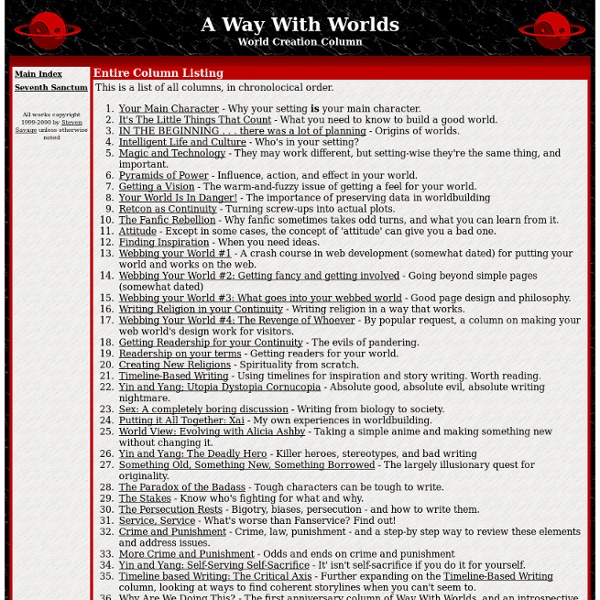



ProFantasy Software ~ map making for RPG, game, historical and h NetHack 3.4.3: Home Page World Builders Home Page Build Your Own World!!! The Language Construction Kit This set of webpages (what’s a set of webpages? a webchapter?) is intended for anyone who wants to create artificial languages— for a fantasy or an alien world, as a hobby, as an interlanguage. It presents linguistically sound methods for creating naturalistic languages— which can be reversed to create non-naturalistic languages. The above is a sample of an artificial language of my own, Verdurian. How about a suite of webpages? Before I could write this little inscription I had to: Decide on the sounds of the language Create the lexicon Create the grammar Design an alphabet Decide how the alphabet is modified for cursive handwriting Translate the desired text You may have two reactions to this: The order of the steps above is significant. Let’s get going! The rest of the kit is organized into three files: If you’d like to read the whole thing as an e-book, it’s available on Amazon for a paltry 99¢. Where do I go from here? There’s a list of web resources here.
Ghyll Round 2 Starting Soon | Gamegrene.com Eight months ago, Gamegrene launched an interactive worldbuilding and roleplaying exercise called Ghyll. Constrained to a small set of rules and the intent of building an integrated encyclopedia where Truth is further refined with each entry, Round 1 is nearly finished, and Round 2 is set to begin in the middle of May. If you're interested in playing, start reading. Eight months ago, some may recall an odd little announcement about the Gamegrene multiplayer game Ghyll. Based on the rules of "Lexicon: an RPG", it constrained players to roleplay themselves as cranky scholars, writing an encyclopedia about a fictional world that didn't yet exist. Round 1, of 26 turns each representing an alphabet letter, is nearly done. Today is the last day for entries starting with Y. If you're interested in joining Round 2 (currently scheduled to start May 14th, a month from now), the first thing to do is start reading. Leave comments here if you've questions, thoughts, or confusions.
List of free massively multiplayer online games - Wikipedia, the This is a selected list of notable massively multiplayer online games which are free to play in some form without ever requiring a subscription or other payment. These are commonly MMORPGs or MMOFPSs, but could be of any genre. Free play[edit] These MMOGs provide client software free of charge and allow users to play the game without requiring payment. Free play with advertising[edit] These MMOGs are free to play. Free play with micro-transactions[edit] These MMOGs are free to play, but players may optionally purchase in-game items or currency. Optional paid subscriptions[edit] These MMOGs offer optional additional game content through paid subscription, but are otherwise free to play. Free play in open or closed beta[edit] These MMOGs are free to play. See also[edit] References[edit]
Last Chaos